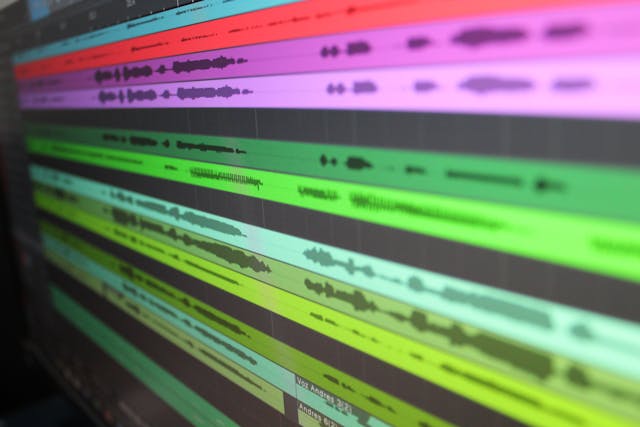When working with audio and video, one of the most common questions is, 'which file format is best for my purpose?'. WAV has long been considered the gold standard for uncompressed, high-quality audio but with dozens of other formats like MP3, AAC, FLAC, MP4, and more, creators often wonder whether they should stick with WAV or switch to something more efficient.
This blog post compares a wide range of formats, audio-to-WAV, WAV-to-audio, and video-to-WAV, so you can see how each stacks up. We’ll also highlight which formats are best for specific purposes such as music, podcasting, archiving, or video production.
Why WAV Is the Benchmark
WAV (Waveform Audio File Format) is an uncompressed, lossless format that stores audio exactly as recorded. At 44.1 kHz/16-bit stereo, it takes up around 10 MB per minute. While it delivers pristine quality, WAV files are very large, making them impractical for casual streaming or sharing.
Because of this, most formats can be compared to WAV in terms of:
-
File size (smaller or larger relative to WAV)
-
Quality (lossless vs lossy)
-
Best use case (editing, streaming, archiving, etc.)
Audio Formats Compared to WAV
|
Format |
Compared to WAV | Compression | Best Use Case |
|---|---|---|---|
| MP3 | MP3 is ~90% smaller | Lossy | Podcasts, streaming, portable listening |
| M4A | M4A (AAC container) ~80–90% smaller | Lossy | Apple ecosystem, iTunes, mobile streaming |
| AAC | AAC ~85% smaller | Lossy | General streaming, YouTube, Spotify |
| FLAC | FLAC is ~50% smaller | Lossless | Archiving, audiophiles, hi-res downloads |
| OGG | OGG ~85% smaller | Lossy | Open-source streaming, gaming audio |
| ALAC | ALAC ~50% smaller | Lossless | Apple lossless playback, archival |
| OPUS | OPUS ~90–95% smaller | Lossy | Real-time voice, low-bandwidth streaming |
| AIFF | Same size as WAV | Uncompressed | Mac workflows, pro audio |
| MP2 | MP2 ~85% smaller | Lossy | Broadcast radio (legacy use) |
| OGA | Same as OGG | Lossy | Web-friendly open audio |
| AIFC | Slightly smaller | Compressed lossless | Professional use, Apple legacy systems |
Video Formats Converted to WAV
Video containers often use AAC or MP3 audio streams inside them. When extracting audio from video, you’re essentially turning that compressed track into WAV.
| Format | Compared to WAV | Compression | Best Use Case |
|---|---|---|---|
| MP4 | MP4 audio ~85% smaller | Lossy | Streaming video, YouTube, online content |
| MOV | MOV audio ~85% smaller | Lossy or uncompressed | Apple video editing, Final Cut workflows |
| MKV | MKV audio varies | Lossy or lossless | Archiving video + multiple tracks |
| AVI | AVI audio ~85% smaller | Usually lossy | Older video playback/editing |
| WMV | WMV audio ~85% smaller | Lossy | Windows video workflows |
| M4V | Similar to MP4 | Lossy | iTunes video |
| FLV | Audio ~85% smaller | Lossy | Legacy Flash video |
| WEBM | Audio ~85% smaller | Lossy | HTML5 video, web browsers |
| MPEG/MPG | Audio ~85% smaller | Lossy | Standard video streams |
| 3GP | Audio up to 95% smaller | Lossy, low bitrate | Mobile video on old devices |
Key Takeaways
-
Lossless formats (WAV, AIFF, FLAC, ALAC, AIFC) preserve original audio quality. Best for editing, archiving, and professional workflows.
-
Lossy formats (MP3, AAC, M4A, OGG, OPUS, MP2) drastically reduce file size. Best for streaming, podcasts, and sharing.
-
Video containers (MP4, MOV, MKV, AVI, etc.) don’t store audio as WAV but often as AAC or MP3. Converting video to WAV extracts the track for editing.
-
WAV is always the largest and can be up to 10× bigger than lossy formats. Use it only when quality and editability matter most.
Which Format Should You Use?
-
For Editing/Mastering: WAV or AIFF are full-quality, uncompressed.
-
For Archiving: FLAC or ALAC are smaller size but still lossless.
-
For Podcasts: MP3 or AAC at 96–128 kbps mono (efficient and universal).
-
For Streaming Music: AAC or MP3 at 192–320 kbps.
-
For Voice/Low Bandwidth: OPUS (efficient, small, great for speech).
-
For Video: Use MP4 with AAC audio; only extract to WAV for editing.
By comparing formats to WAV, you can decide when to keep maximum fidelity and when to prioritize efficiency, ensuring your audio and video projects sound great while remaining practical to store, share, and stream.
